Seagate Backup Plus Portable 5TB & Backup Plus Slim 2TB Review: SMR for the Consumer Market
by Ganesh T S on June 18, 2019 8:00 AM ESTInvestigating SMR for Consumer Workloads
The nature of the platters in a hard drive (CMR or SMR), unless explicitly mentioned, is not immediately evident from the specifications or even artificial benchmark tests that use a small work set. Even replaying real-world work traces often only provides slight hints about the presence of SMR. Our first tryst with SMR in the lab was the 8TB Seagate Archive HDD, followed by the retail-focused Seagate Innov8. While the Archive HDD (one of the first SMR drives from Seagate that went into mass production) had dismal performance consistency, the Innov8 carried substantially improved firmware that enabled much better overall performance numbers. With the passage of time, Seagate has improved the firmware to such an extent that the tests detailed in the link above can no longer reliably detect the presence of SMR in a drive.
Detecting SMR - The Sequential Writes Test
One of the tests we have recently started doing on flash-based storage devices is performance consistency under extremely stressful sequential write workloads. The fio workload used for this purpose was adapted for running on the external hard drives. This 128K sequential write workload was set to span the entire capacity of the drive. First off, we take a look at the processing of this workload on a CMR drive - the WD My Passport 4TB.
We see the bandwidth numbers between 90 MBps and 110 MBps as we start off at the outer edge of the platters. We see a gradual steady drop down to 50-70 MBps as we move towards the center. This drop (based on the sector location in the drive's platters) is a well-known phenomenon due to the presence of a larger number of sectors on a per-revolution basis as we move further away from the center of the platter.
The Seagate Backup Plus Slim, on the other hand, starts off between 125 and 135 MBps and ends up between 60 and 80 MBps. Worryingly, we have drops down to 10 MBps frequently. It can be seen that the firmware tries to avoid these slow write scenarios as much as possible (almost a hour of sustained sequential writes), but, the amount of traditional PMR space in the platters eventually runs out and the drive is forced to record to the shingled space. This results in the drop of the instantaneous write rates to 10 MBps periodically.
The same behavior is seen in the Seagate Backup Plus Portable 5TB drive also.
The 5TB drive is actually able to avoid writing to the SMR space for more than 90 minutes before yielding to the inevitable.
Backing up System Images - A Real World Test
Sustained sequential writes for a hour or more are not realistic workloads for a majority of the retail consumers. However, it must be noted that the drop in transfer rates may start to happen after all the non-shingled areas are already filled with data. Thus, once the SMR drive is, say 20 - 25% full, it is likely that users will see considerably worse performance compared to a fresh drive. To test this, we brought back the LaCie Porsche Design Mobile 4TB (also a SMR drive) and filled it to around 14% of the capacity with system images of different PCs created using the System Image Backup native utility in Windows. The same data was also used to put the other hard drives in the 'used' state.
A system image of the testbed was then taken on the extrnal drive, while the read and write transfer rates to the drive were monitored.
The WD My Passport 4TB shows the system image write out being consistently between 70 MBps and 110 MBps. In contrast, the Porsche Design Mobile drive (of the same capacity) had frequent dips to around 20 MBps. The peaks were higher at 130 MBps. Despite the higher peaks, the LaCie Porsche Design Mobile took more time compared to the WD My Passport for recording the system image.
Graphs for the same scenario involving the Backup Plus Slim and Backup Plus portable show that the SMR issue is still exposed. However, the valleys are spread much farther apart compared to the LaCie Porsche Design Mobile from a couple of years back.
SMR drives do show higher peak performance numbers compared to CMR drives with the same capacity. However, the lack of performance consistency means that a CMR drive is a more predicable medium for typical consumer workloads in the long run.


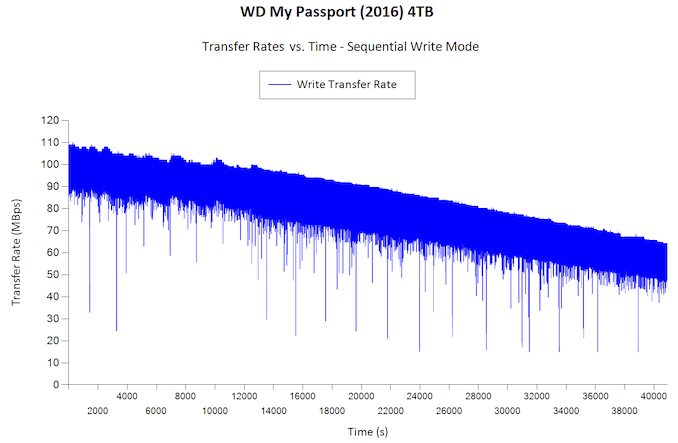


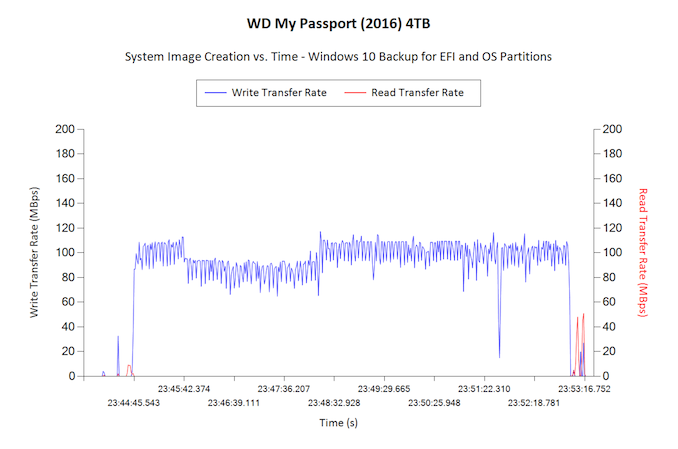
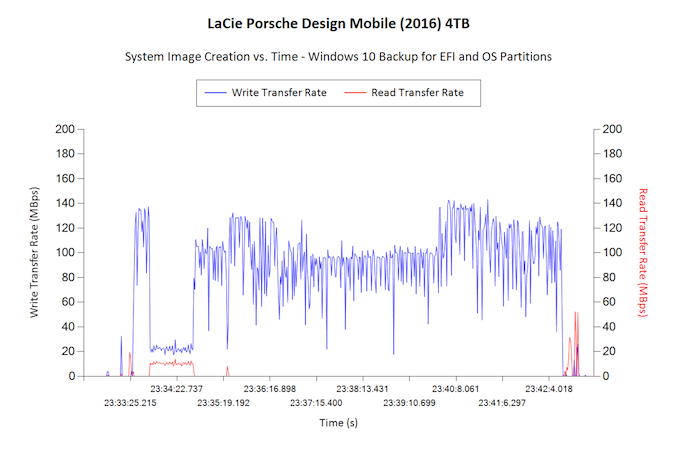
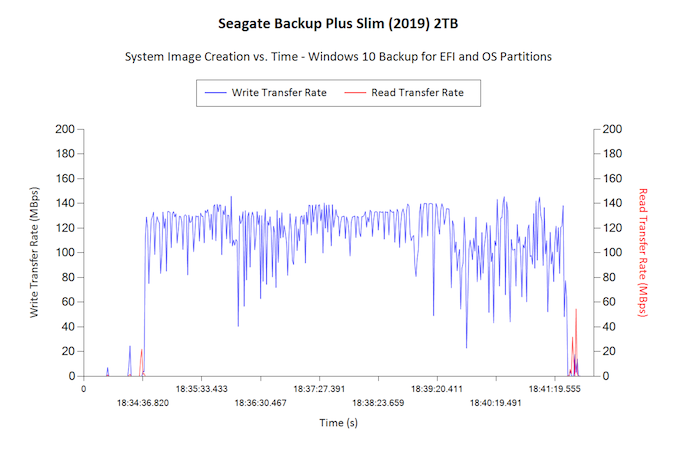
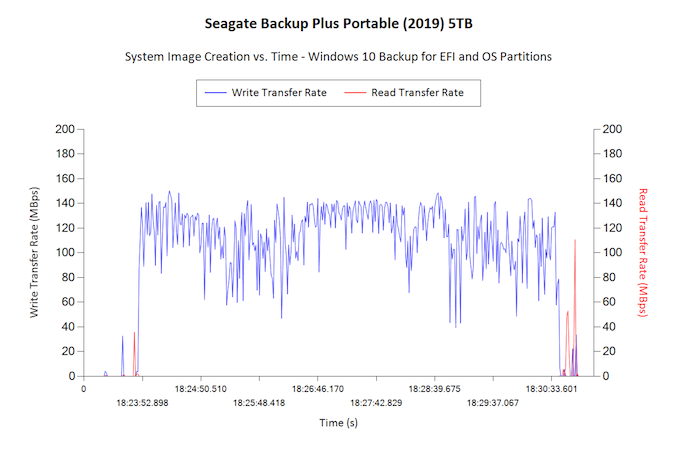








62 Comments
View All Comments
Sivar - Tuesday, June 18, 2019 - link
This is an interesting way to look at it, but it makes sense.Benchmarks for small writes have not gone well for early SMR drives, though that may have improved since. I suspect they would make great storage drives for movies, music, images, or other large files.
abufrejoval - Wednesday, June 19, 2019 - link
I wonder about the command set, too. Crystal disk info typically mentions TRIM support and doesn't show it the posted picture. Dunno if it asks HDDs for TRIM or if the command set is different.There must be some way to control that behavior otherwise the hyperscalers wouldn't have co-invented them with the HDD manufacturers.
Arbie - Tuesday, June 18, 2019 - link
Thanks for the excellent article evaluating these drives and describing the state of SMR. It's good to see that the process has improved.Seagate nowadays makes it very difficult to determine before purchase if a drive is SMR or CMR. As a result I've gotten into the habit of just going for other brands first - not the best approach, certainly, but I'm only willing to do just so much research.
oRAirwolf - Tuesday, June 18, 2019 - link
I use 7 of the 4TB Seagate drives shucked out of their enclosures in a Dell R620 SFF sitting in a data center. The drives have cold air constantly moving over them and see use as a RAID 5 storage array with the Dell H710P (LSI SAS2208) RAID controller handling everything. They are used for media storage and see very little write activity. These drives drop like flies. If I get 6 months out of them, I feel lucky. Of the 7 drives in the server over the past 1.5 years, I have had to replace 5 of them. I only use them because of their density and the fact I am kind of locked into them at this point. I would not recommend these things to my worst enemy, though.I would definitely spend the extra on a WD if it is going to be used with it's external enclosure. Sadly, the WD drives have the USB connector directly soldered to the drive, rather than using a SATA to USB adapter like the Seagate.
Seeing as how bad their CMR drives are, though, I can't even imagine how bad the SMR drives are. Maybe it would help if they put an iron wolf sticker on them like their other drives. Then it would be strong like iron and loyal like wolf.
takeshi7 - Tuesday, June 18, 2019 - link
The "cold air constantly moving over them" might be part of the problem. Hard drives like to operate at warm temperatures. They're designed that waytakeshi7 - Tuesday, June 18, 2019 - link
And also running shucked drives in RAID just sounds like a terrible idea.Qasar - Wednesday, June 19, 2019 - link
sounds like oRAirwolf is using hdds that aren't made for the use case he is putting them in, and they are just wearing out, and as was mentioned.. the constant cold air.. cant be good. maybe went the inexpensive way vs the slightly more expensive way just to save a few bucks ?BeethovensCat - Tuesday, June 18, 2019 - link
Are there any rumors or reliable information about WD releasing a 5Tb or 6Tb version of their Passport/Elements series drives? I have a number of 3Tb drives and they are getting too small. Have been holding on to them in the hope that there will be a 5Tb version available sometime during 2019. Has anyone heard anything. Would like to avoid the large drives with power cables etc.fmcjw - Tuesday, June 18, 2019 - link
no innovation in this area. BTW, the article, being Anandtech, should've looked into background shuttling of data across shingles, which expend precious energy to gain performance (much like a TLC SSD), but also increase wear. And how about read performance compared to non-SMR drives?fmcjw - Tuesday, June 18, 2019 - link
no innovation for about 3 years, just enclosure changes.